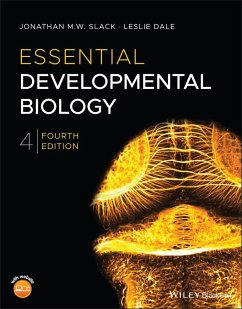Jonathan M. W. Slack (UK University of Bath), Leslie Dale (UK University College London)
Essential Developmental Biology
Jonathan M. W. Slack (UK University of Bath), Leslie Dale (UK University College London)
Essential Developmental Biology
- Broschiertes Buch
- Merkliste
- Auf die Merkliste
- Bewerten Bewerten
- Teilen
- Produkt teilen
- Produkterinnerung
- Produkterinnerung
Essential Developmental Biology ist eine umfassende und reich illustrierte Einführung in sämtliche Aspekte der Entwicklungsbiologie. Die 3. Auflage dieses beliebten und zugänglichen Lehrbuchs wurde erweitert und aktualisiert.
Die begleitende Website bietet darüber hinaus Lehr- und Lernmaterialien für Studenten und Dozenten, animierte Entwicklungsprozesse, eine Fotogalerie ausgewählter Modellorganismen und sämtliche Abbildungen usw. der Printversion zum Herunterladen.
Dieses evidenzbasierte Lehrbuch liefert durchgängig Belege für zentrale Schlussfolgerungen und ist ein Muss sowohl für Einführungs- als auch Aufbaukurse der Entwicklungsbiologie. …mehr
Andere Kunden interessierten sich auch für
![Developmental Biology Developmental Biology]() Michael J.F. Barresi (Professor o Professor of Biological SciencesDevelopmental Biology207,99 €
Michael J.F. Barresi (Professor o Professor of Biological SciencesDevelopmental Biology207,99 €![Understanding Reproduction Understanding Reproduction]() Giuseppe Fusco (Italy Universita degli Studi di Padova)Understanding Reproduction16,99 €
Giuseppe Fusco (Italy Universita degli Studi di Padova)Understanding Reproduction16,99 €![Why Elephants Cry Why Elephants Cry]() John T. HancockWhy Elephants Cry47,99 €
John T. HancockWhy Elephants Cry47,99 €![Why Elephants Cry Why Elephants Cry]() John T. HancockWhy Elephants Cry132,99 €
John T. HancockWhy Elephants Cry132,99 €![Eve Eve]() Cat BohannonEve12,99 €
Cat BohannonEve12,99 €![The Teenage Brain The Teenage Brain]() Frances E. JensenThe Teenage Brain22,99 €
Frances E. JensenThe Teenage Brain22,99 €![Handbook of Marine Model Organisms in Experimental Biology Handbook of Marine Model Organisms in Experimental Biology]() Handbook of Marine Model Organisms in Experimental Biology104,99 €
Handbook of Marine Model Organisms in Experimental Biology104,99 €-
-
-
Essential Developmental Biology ist eine umfassende und reich illustrierte Einführung in sämtliche Aspekte der Entwicklungsbiologie. Die 3. Auflage dieses beliebten und zugänglichen Lehrbuchs wurde erweitert und aktualisiert.
Die begleitende Website bietet darüber hinaus Lehr- und Lernmaterialien für Studenten und Dozenten, animierte Entwicklungsprozesse, eine Fotogalerie ausgewählter Modellorganismen und sämtliche Abbildungen usw. der Printversion zum Herunterladen.
Dieses evidenzbasierte Lehrbuch liefert durchgängig Belege für zentrale Schlussfolgerungen und ist ein Muss sowohl für Einführungs- als auch Aufbaukurse der Entwicklungsbiologie.
Hinweis: Dieser Artikel kann nur an eine deutsche Lieferadresse ausgeliefert werden.
Die begleitende Website bietet darüber hinaus Lehr- und Lernmaterialien für Studenten und Dozenten, animierte Entwicklungsprozesse, eine Fotogalerie ausgewählter Modellorganismen und sämtliche Abbildungen usw. der Printversion zum Herunterladen.
Dieses evidenzbasierte Lehrbuch liefert durchgängig Belege für zentrale Schlussfolgerungen und ist ein Muss sowohl für Einführungs- als auch Aufbaukurse der Entwicklungsbiologie.
Hinweis: Dieser Artikel kann nur an eine deutsche Lieferadresse ausgeliefert werden.
Produktdetails
- Produktdetails
- Verlag: Wiley / Wiley & Sons
- Artikelnr. des Verlages: 1W119512850
- 4. Aufl.
- Seitenzahl: 544
- Erscheinungstermin: 16. Dezember 2021
- Englisch
- Abmessung: 275mm x 215mm x 28mm
- Gewicht: 1454g
- ISBN-13: 9781119512851
- ISBN-10: 1119512859
- Artikelnr.: 60123832
- Herstellerkennzeichnung
- Libri GmbH
- Europaallee 1
- 36244 Bad Hersfeld
- gpsr@libri.de
- Verlag: Wiley / Wiley & Sons
- Artikelnr. des Verlages: 1W119512850
- 4. Aufl.
- Seitenzahl: 544
- Erscheinungstermin: 16. Dezember 2021
- Englisch
- Abmessung: 275mm x 215mm x 28mm
- Gewicht: 1454g
- ISBN-13: 9781119512851
- ISBN-10: 1119512859
- Artikelnr.: 60123832
- Herstellerkennzeichnung
- Libri GmbH
- Europaallee 1
- 36244 Bad Hersfeld
- gpsr@libri.de
Professor Jonathan M.W. Slack is an emeritus professor of the University of Bath, UK, where he was Head of the Department of Biology and Biochemistry; and the University of Minnesota, USA, where he was director of the Stem Cell Institute. He is a member of the European Molecular Biology Organization and a ??Fellow of the Academy of Medical Sciences. He has published numerous research papers on developmental biology as well as five other books, including The Science of Stem Cells (Wiley-Blackwell 2018). Professor Leslie Dale is Professor of Developmental Biology at University College London, UK, where he was Head of Teaching for the Department of Cell and Developmental Biology. He teaches developmental biology to both undergarduate and medical students. For his PhD he studied regeneration in Drosophila imaginal discs and subsequently the development of Xenopus embryos.
Preface, ix
About the companion website, xi
Section 1: Groundwork, 1
1 The excitement of developmental biology, 3
Where the subject came from, 3
Impact of developmental biology, 4
Future impact, 5
2 How development works, 7
Ultrashort summary, 7
Gametogenesis, 10
Early development, 13
Growth and death, 19
3 Approaches to development: developmental genetics, 25
Developmental mutants, 25
Sex chromosomes, 27
Maternal and zygotic, 27
Genetic pathways, 28
Genetic mosaics, 30
Screening for mutants, 31
Cloning of genes, 32
Gain-and loss-of-function experiments, 32
Transgenesis, 32
Other gain-of- function techniques, 34
Targeted mutagenesis, 34
Other loss-of- function systems, 35
Gene duplication, 36
Limitations of developmental genetics, 37
4 Approaches to development: experimental embryology and its molecular basis, 39
Normal development, 39
Developmental commitment, 42
Criteria for proof, 48
Transcription factors, 48
Transcription factor families, 50
Other controls of gene activity, 51
Signaling systems, 51
Genetic regulatory networks, 57
5 Approaches to development: cell and molecular biology techniques, 61
Microscopy, 61
Optical techniques, 61
Confocal, multi-photon, and light sheet microscopes, 63
Image capture, 63
Anatomical and histological methods, 64
Microinjection, 66
Study of gene expression by molecular biology methods, 67
Study of gene expression by in situ methods, 72
Reporter genes, 75
Cell-labeling methods, 76
6 Cells into tissues, 81
Cells in embryos, 81
Cytoskeleton, 82
Small GTP-binding proteins, 84
Extracellular matrix, 84
Cell movement, 85
Epithelial organization, 86
Morphogenetic processes, 88
Section 2: Major model organisms, 97
7 Major model organisms, 99
The big six, 99
Access and micromanipulation, 101
Genetics and genomes, 101
Relevance and tempo, 102
Other organisms, 102
8 Xenopus, 107
Oogenesis, maturation, and fertilization, 108
Normal development, 109
Fate maps, 114
Experimental methods, 115
Processes of regional specification, 119
9 The zebrafish, 135
Normal development, 135
Fate map, 140
Genetics, 141
Reverse genetic methods, 144
Embryological techniques, 145
Regional specification, 145
Other roles of the zebrafish, 150
10 The chick, 153
Normal development, 154
Fate map, 158
Regional specification of the early embryo, 159
Description of organogenesis in the chick, 164
11 The mouse, 173
Mammalian fertilization, 173
Normal development of the mouse, 177
Fate map, 184
Regional specification in the mouse embryo, 185
Transgenic mice, 190
Embryonic stem cells, 192
Knockouts and knock-ins, 192
Nuclear transplantation and imprinting, 196
X-inactivation, 196
Teratocarcinoma, 198
12 Human early development, 203
Human reproduction, 203
Preimplantation development, 205
Human embryonic stem cells, 207
About the companion website, xi
Section 1: Groundwork, 1
1 The excitement of developmental biology, 3
Where the subject came from, 3
Impact of developmental biology, 4
Future impact, 5
2 How development works, 7
Ultrashort summary, 7
Gametogenesis, 10
Early development, 13
Growth and death, 19
3 Approaches to development: developmental genetics, 25
Developmental mutants, 25
Sex chromosomes, 27
Maternal and zygotic, 27
Genetic pathways, 28
Genetic mosaics, 30
Screening for mutants, 31
Cloning of genes, 32
Gain-and loss-of-function experiments, 32
Transgenesis, 32
Other gain-of- function techniques, 34
Targeted mutagenesis, 34
Other loss-of- function systems, 35
Gene duplication, 36
Limitations of developmental genetics, 37
4 Approaches to development: experimental embryology and its molecular basis, 39
Normal development, 39
Developmental commitment, 42
Criteria for proof, 48
Transcription factors, 48
Transcription factor families, 50
Other controls of gene activity, 51
Signaling systems, 51
Genetic regulatory networks, 57
5 Approaches to development: cell and molecular biology techniques, 61
Microscopy, 61
Optical techniques, 61
Confocal, multi-photon, and light sheet microscopes, 63
Image capture, 63
Anatomical and histological methods, 64
Microinjection, 66
Study of gene expression by molecular biology methods, 67
Study of gene expression by in situ methods, 72
Reporter genes, 75
Cell-labeling methods, 76
6 Cells into tissues, 81
Cells in embryos, 81
Cytoskeleton, 82
Small GTP-binding proteins, 84
Extracellular matrix, 84
Cell movement, 85
Epithelial organization, 86
Morphogenetic processes, 88
Section 2: Major model organisms, 97
7 Major model organisms, 99
The big six, 99
Access and micromanipulation, 101
Genetics and genomes, 101
Relevance and tempo, 102
Other organisms, 102
8 Xenopus, 107
Oogenesis, maturation, and fertilization, 108
Normal development, 109
Fate maps, 114
Experimental methods, 115
Processes of regional specification, 119
9 The zebrafish, 135
Normal development, 135
Fate map, 140
Genetics, 141
Reverse genetic methods, 144
Embryological techniques, 145
Regional specification, 145
Other roles of the zebrafish, 150
10 The chick, 153
Normal development, 154
Fate map, 158
Regional specification of the early embryo, 159
Description of organogenesis in the chick, 164
11 The mouse, 173
Mammalian fertilization, 173
Normal development of the mouse, 177
Fate map, 184
Regional specification in the mouse embryo, 185
Transgenic mice, 190
Embryonic stem cells, 192
Knockouts and knock-ins, 192
Nuclear transplantation and imprinting, 196
X-inactivation, 196
Teratocarcinoma, 198
12 Human early development, 203
Human reproduction, 203
Preimplantation development, 205
Human embryonic stem cells, 207
Preface, ix
About the companion website, xi
Section 1: Groundwork, 1
1 The excitement of developmental biology, 3
Where the subject came from, 3
Impact of developmental biology, 4
Future impact, 5
2 How development works, 7
Ultrashort summary, 7
Gametogenesis, 10
Early development, 13
Growth and death, 19
3 Approaches to development: developmental genetics, 25
Developmental mutants, 25
Sex chromosomes, 27
Maternal and zygotic, 27
Genetic pathways, 28
Genetic mosaics, 30
Screening for mutants, 31
Cloning of genes, 32
Gain-and loss-of-function experiments, 32
Transgenesis, 32
Other gain-of- function techniques, 34
Targeted mutagenesis, 34
Other loss-of- function systems, 35
Gene duplication, 36
Limitations of developmental genetics, 37
4 Approaches to development: experimental embryology and its molecular basis, 39
Normal development, 39
Developmental commitment, 42
Criteria for proof, 48
Transcription factors, 48
Transcription factor families, 50
Other controls of gene activity, 51
Signaling systems, 51
Genetic regulatory networks, 57
5 Approaches to development: cell and molecular biology techniques, 61
Microscopy, 61
Optical techniques, 61
Confocal, multi-photon, and light sheet microscopes, 63
Image capture, 63
Anatomical and histological methods, 64
Microinjection, 66
Study of gene expression by molecular biology methods, 67
Study of gene expression by in situ methods, 72
Reporter genes, 75
Cell-labeling methods, 76
6 Cells into tissues, 81
Cells in embryos, 81
Cytoskeleton, 82
Small GTP-binding proteins, 84
Extracellular matrix, 84
Cell movement, 85
Epithelial organization, 86
Morphogenetic processes, 88
Section 2: Major model organisms, 97
7 Major model organisms, 99
The big six, 99
Access and micromanipulation, 101
Genetics and genomes, 101
Relevance and tempo, 102
Other organisms, 102
8 Xenopus, 107
Oogenesis, maturation, and fertilization, 108
Normal development, 109
Fate maps, 114
Experimental methods, 115
Processes of regional specification, 119
9 The zebrafish, 135
Normal development, 135
Fate map, 140
Genetics, 141
Reverse genetic methods, 144
Embryological techniques, 145
Regional specification, 145
Other roles of the zebrafish, 150
10 The chick, 153
Normal development, 154
Fate map, 158
Regional specification of the early embryo, 159
Description of organogenesis in the chick, 164
11 The mouse, 173
Mammalian fertilization, 173
Normal development of the mouse, 177
Fate map, 184
Regional specification in the mouse embryo, 185
Transgenic mice, 190
Embryonic stem cells, 192
Knockouts and knock-ins, 192
Nuclear transplantation and imprinting, 196
X-inactivation, 196
Teratocarcinoma, 198
12 Human early development, 203
Human reproduction, 203
Preimplantation development, 205
Human embryonic stem cells, 207
About the companion website, xi
Section 1: Groundwork, 1
1 The excitement of developmental biology, 3
Where the subject came from, 3
Impact of developmental biology, 4
Future impact, 5
2 How development works, 7
Ultrashort summary, 7
Gametogenesis, 10
Early development, 13
Growth and death, 19
3 Approaches to development: developmental genetics, 25
Developmental mutants, 25
Sex chromosomes, 27
Maternal and zygotic, 27
Genetic pathways, 28
Genetic mosaics, 30
Screening for mutants, 31
Cloning of genes, 32
Gain-and loss-of-function experiments, 32
Transgenesis, 32
Other gain-of- function techniques, 34
Targeted mutagenesis, 34
Other loss-of- function systems, 35
Gene duplication, 36
Limitations of developmental genetics, 37
4 Approaches to development: experimental embryology and its molecular basis, 39
Normal development, 39
Developmental commitment, 42
Criteria for proof, 48
Transcription factors, 48
Transcription factor families, 50
Other controls of gene activity, 51
Signaling systems, 51
Genetic regulatory networks, 57
5 Approaches to development: cell and molecular biology techniques, 61
Microscopy, 61
Optical techniques, 61
Confocal, multi-photon, and light sheet microscopes, 63
Image capture, 63
Anatomical and histological methods, 64
Microinjection, 66
Study of gene expression by molecular biology methods, 67
Study of gene expression by in situ methods, 72
Reporter genes, 75
Cell-labeling methods, 76
6 Cells into tissues, 81
Cells in embryos, 81
Cytoskeleton, 82
Small GTP-binding proteins, 84
Extracellular matrix, 84
Cell movement, 85
Epithelial organization, 86
Morphogenetic processes, 88
Section 2: Major model organisms, 97
7 Major model organisms, 99
The big six, 99
Access and micromanipulation, 101
Genetics and genomes, 101
Relevance and tempo, 102
Other organisms, 102
8 Xenopus, 107
Oogenesis, maturation, and fertilization, 108
Normal development, 109
Fate maps, 114
Experimental methods, 115
Processes of regional specification, 119
9 The zebrafish, 135
Normal development, 135
Fate map, 140
Genetics, 141
Reverse genetic methods, 144
Embryological techniques, 145
Regional specification, 145
Other roles of the zebrafish, 150
10 The chick, 153
Normal development, 154
Fate map, 158
Regional specification of the early embryo, 159
Description of organogenesis in the chick, 164
11 The mouse, 173
Mammalian fertilization, 173
Normal development of the mouse, 177
Fate map, 184
Regional specification in the mouse embryo, 185
Transgenic mice, 190
Embryonic stem cells, 192
Knockouts and knock-ins, 192
Nuclear transplantation and imprinting, 196
X-inactivation, 196
Teratocarcinoma, 198
12 Human early development, 203
Human reproduction, 203
Preimplantation development, 205
Human embryonic stem cells, 207








